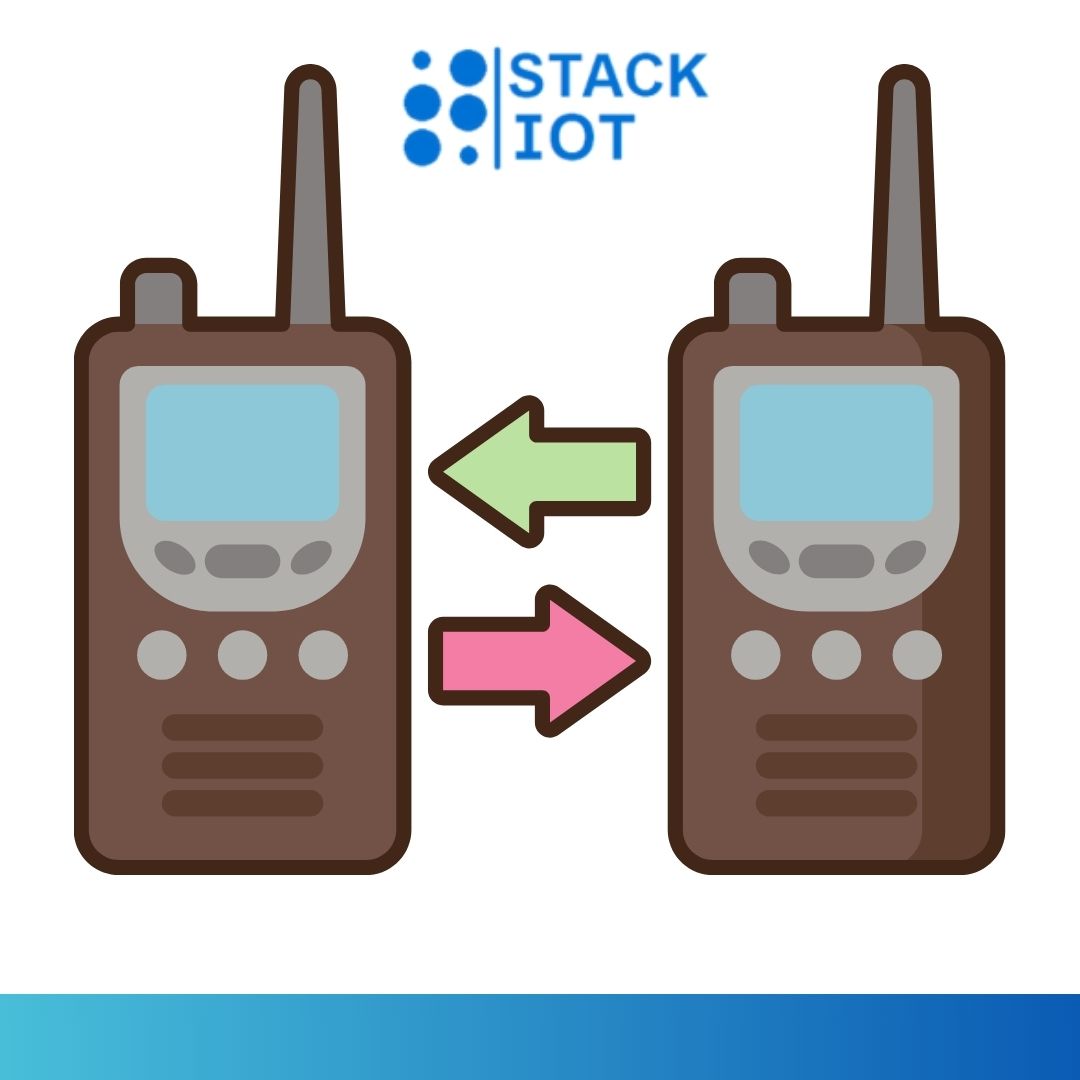In the age of smartphones, 5G and cloud environments, it is easy to overlook that the basis of all the modern wireless systems was initiated by something elementary radio to radio communication. Since the first use of analog transceivers, up to modern radio networks that are digital and IP enabled, radio communication has been one of the most dependable, effective and stable forms of connectivity.
This blog will examine the development of wireless radio communication, its continued relevance in the current world, and how the current radio communication systems keep innovating, such as the handheld radios and the hybrid radio app without internet, that combines the old and the new worlds.
What Radio is to Radio Communication?
Radio to radio communication is the simplest and is the transmission of audio signals by two or more radios using radio frequency (RF) waves. This is unlike cellular or internet based systems as it does not require any external structure such as towers, routers or cables, it only requires the radios and all of them tuned to the same frequency. The radio is a transmitter and a receiver and thus two-way communication is possible in real time.
Commonly used in:
- Law and order (police, fire, EMS)
- Construction and logistics
- Security and defense
- Marine and aviation
- Hospitality, events and remote sites
These radio networks continue to provide the basis of mission-critical communication – particularly where reliability is more important than speed.
The Operation of Wireless Radio Communication.
The principle of wireless radio communication is not very complicated but strong.
- A user clicks the push-to-talk (PTT) button of his/her radio.
- The voice of the user is converted to electrical signals by the radio.
- These signals regulate a radio frequency carrier wave and cope it.
- The signal is received by other radios on the same frequency and demodulated into sound again.
Depending on the type of system — analog, digital, or trunked — these transmissions can cover short distances (a few kilometers) or vast areas when repeaters or gateways are used.
From Analog to Digital: The Evolution of Radio Systems
Over the decades, radio communication systems have undergone several transformative stages:
| Era | Technology | Key Features | Impact |
| Pre-1980s | Analog FM/AM Radios | Simple, reliable voice-only communication | First responders and military |
| 1980s–1990s | Trunked & Repeater Networks | Automatic channel management | Improved scalability |
| 2000s | Digital Radios (DMR, TETRA, P25) | Clearer audio, encryption, GPS | Broader public safety adoption |
| 2010s–Present | IP & Hybrid Radio Systems | Internet and cellular integration | Global coverage and interoperability |
Each phase added better clarity, larger coverage, and new capabilities such as text messaging, GPS tracking, and secure communication.
The Rise of Hybrid Radio Communication Systems
There is no longer a restriction of the modern radio communication systems to only analog signals. They mix the old RF technology with IP and cellular networks and form hybrid systems which are able to bridge radio users, smartphone users, and dispatch consoles.
Hybrid Systems Offer:
- Expansive Area: Link to several cities or nations through RoIP (Radio over IP).
- Cross-Platform Communication: Radios, smartphones and tablets are all able to communicate with each other within a single network.
- Better Resilience: Direct radio-to-radio mode works even in the case of internet or cellular outage.
- Scalability: With mobile applications, new users can be added without the need of purchasing additional hardware.
This interoperability has redefined communication in the areas of public safety, logistics and in the field operations, by making radio communication more flexible and future ready.
Radio Apps Without Internet — A Modern Twist
With the development of mobile technology, software developers started creating radio applications that can run without an internet connection but emulate or extend the functionality of a traditional radio.
These apps use:
- Wi-Fi Direct / Bluetooth Mesh: in order to establish ad-hoc, peer-to-peer networks without the use of data service.
- Local RF or mesh devices: in order to connect local users.
- Offline PTT systems: the ability to communicate in uncovered areas.
- These are internet-free radio applications that are becoming increasingly popular in:
- Rural areas or Disaster zones.
- Trekking, adventure travel, or hiking.
- Rescue missions of the military and emergency.
- On-site event management
They keep the essence of traditional radio to radio communication, providing the users with autonomy to traditional networks which is very vital in situations where connectivity infrastructure fails.
Advantages of Radio to Radio Communication
Radio communication is still indispensable in most areas due to a number of reasons:
- Not addicted to the internet or mobile towers
- One button push-to-talk instant communication
- Very dependable and able to survive harsh conditions
- Economical after the hardware has been installed
- Digital encryption is available, and it is private and secure
- Flexible and scalable team or group communication
These advantages explain why, even in 2025, industries still rely heavily on wireless radio communication for field operations.
How Radio Communication Influences Modern Connectivity
While 5G, IoT, and satellite systems are in the spotlight, their underlying concepts borrow heavily from early radio systems.
Here’s how radio technology shaped modern connectivity:
| Radio Innovation | Modern Counterpart | Description |
| RF Signaling | 5G & Wi-Fi | Core wireless principles |
| Trunked Networks | Cellular Towers | Channel allocation and routing |
| RoIP (Radio over IP) | VoIP, PoC | Voice over IP transmission |
| Push-to-Talk | Messaging Apps | Real-time communication |
| Mesh Networks | IoT Devices | Device-to-device communication |
Essentially, the evolution of radio communication laid the foundation for the wireless world we live in today.
Challenges and Modern Solutions
The traditional radio systems have some challenges regardless of their benefits:
- Low range on no repeaters.
- Congestion at the frequency in urban areas.
- Channel tuning and management manually.
- Absence of sophisticated analytics or cloud implementation.
Solutions are emerging fast:
- Digital Trunked Systems (such as DMR and TETRA) enhance efficiency of frequencies.
- Radio over IP (RoIP) involves the use of internet to connect remote networks.
- Smart Gateways are capable of integrating with LTE, 5G and PTT apps.
- AI and cloud dashboards advance network and predictive maintenance.
The outcome is a new breed of radio communication systems that are smart, safe and wireless on a worldwide scale without losing the simplicity that made radio popular in the first place.
The Future of Wireless Radio Communication
Radio networks in the future will not replace 5G, IoT, or satellite systems but will have to collaborate with them.
Emerging trends include:
- Privatized LTE/5G + Radio Integration: Integrated mission-critical systems.
- Artificial intelligence spectrum management: Automatic frequency optimization.
- Edge-based radio servers Faster call set up and lower latency.
- Linked dispatch consoles in the cloud: Command visibility, analytics and real-time tracking.
- Smartphone-radio hybrids: Cellular and RF hybrids.
The wireless radio communication development is passing into the phase, when the traditional reliability is combined with the modern intelligence.
Conclusion
Since the early 1900s, battlefield communication used radio to radio communication, and today, radio to radio communication has transformed the way human beings communicate – setting the groundwork of all the wireless technologies that we are so reliant on today.
The radio communication systems are still unsurpassed in terms of reliability, immediate accessibility, and ease even during a hyper-digital era. And as the hybrid systems and radio apps come, with no internet, the history of radio still moves on to a greater level more than ever before.
StackIOT is the company that can help you to discover high-tech integrated communication systems, adjusted to the business needs of a modern enterprise.
FAQs
1. What is Radio to Radio Communication?
It is a method of transmitting voice signals directly between radios using radio waves, without relying on mobile networks or the internet.
2. How does Wireless Radio Communication work?
Wireless radios transmit and receive voice or data over specific radio frequencies. They can work independently or be connected via repeaters, gateways, or IP networks for extended coverage.
3. What is a Radio App Without Internet?
It’s a mobile application that allows users to communicate locally using Bluetooth, Wi-Fi Direct, or mesh networks, enabling offline communication in areas with no internet connectivity.
4. Are Radio Communication Systems still relevant?
Absolutely. Industries like defense, public safety, logistics, and construction rely on radio because it offers unmatched reliability and instant connectivity — even when other networks fail.
5. How is Radio Communication evolving with technology?
Modern systems now integrate with IP networks, LTE, and cloud platforms, offering hybrid connectivity that bridges radios, smartphones, and dispatch consoles.




